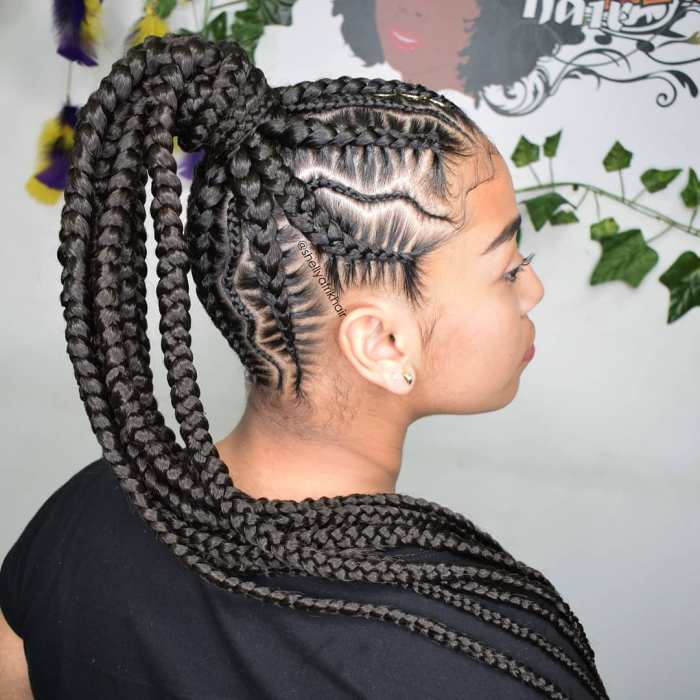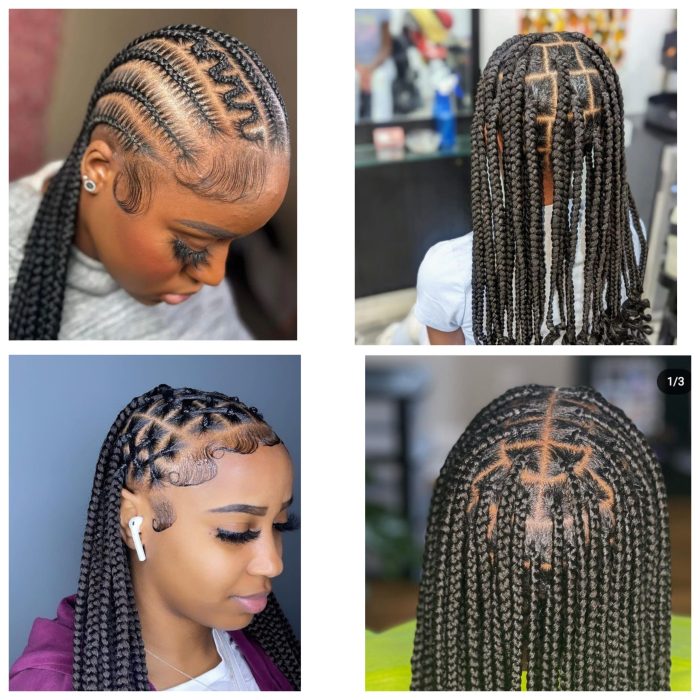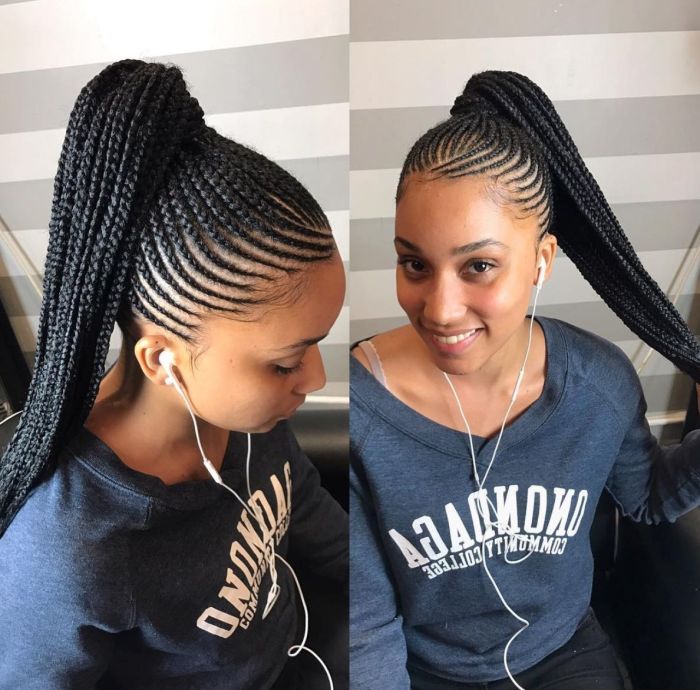African Hair Braiding Hairstyles A Comprehensive Guide
African Hair Braiding Hairstyles: A Rich History and Diverse Styles
African hair braiding hairstyles – African hair braiding represents a rich tapestry of cultural heritage, artistic expression, and social significance. From ancient traditions to contemporary trends, braiding has served as a powerful means of communication, adornment, and identity formation across diverse African communities. This exploration delves into the history, techniques, styles, and cultural impact of this enduring practice.
A History and Cultural Significance of African Hair Braiding
The practice of African hair braiding dates back centuries, with evidence suggesting its presence in ancient Egypt and other parts of the continent. Braids were not merely decorative; they often conveyed social status, marital status, age, and tribal affiliation. Complex braiding patterns served as a form of visual storytelling, transmitting cultural narratives and knowledge through generations. The intricate designs and techniques varied significantly across different regions and ethnic groups, reflecting the unique cultural identities of each community.
Diverse Braiding Techniques Across African Cultures
The diversity of braiding techniques in Africa is remarkable. Different cultures developed unique methods, utilizing various tools and materials. Some common techniques include cornrows, which involve braiding hair close to the scalp; box braids, which utilize extensions to create thicker, longer braids; twists, which involve twisting strands of hair together; and Senegalese twists, a variation of twists that often incorporate extensions.
Evolution of African Hair Braiding Styles in Modern Times
Modern African hair braiding styles have evolved significantly, incorporating influences from global trends while retaining their cultural roots. The use of synthetic hair extensions has broadened creative possibilities, enabling the creation of elaborate styles with increased length and volume. Contemporary stylists have also integrated elements from other hairdressing traditions, resulting in a dynamic fusion of styles that celebrate both heritage and innovation.
This evolution reflects a growing global appreciation for the artistry and versatility of African hair braiding.
Popular African Hair Braiding Styles
Numerous popular styles exist, each offering unique aesthetic qualities and practical considerations. Understanding the differences helps in choosing the best style based on personal preferences and lifestyle.
| Style | Description | Complexity | Maintenance |
|---|---|---|---|
| Cornrows | Close-to-scalp braids, often intricate and geometric. Variations include straight, curved, and patterned designs. Images often showcase the clean lines and precision of the style. | Medium to High (depending on pattern complexity) | Medium (regular washing and moisturizing) |
| Box Braids | Square-shaped braids created using extensions, offering versatility in length and thickness. Images highlight the bold, defined look and the range of possible braid sizes. | Medium | Medium (regular washing and moisturizing) |
| Twists | Two-strand twists that create a natural, textured look. Variations include two-strand twists and flat twists. Images show the soft, flowing texture of the style. | Low | Low (regular washing and moisturizing) |
| Senegalese Twists | Similar to twists, but often longer and created with extensions. Images demonstrate the elegant, flowing look of this style. | Medium | Medium (regular washing and moisturizing) |
Detailed Descriptions of Braiding Styles
Beyond the table, let’s explore some styles in more depth. Cornrows, for instance, can range from simple straight lines to elaborate geometric patterns. Box braids allow for customization in thickness, length, and color, offering a wide array of options. Twists provide a more relaxed and natural look, perfect for everyday wear. Senegalese twists offer a similar aesthetic to box braids but with a slightly different texture.
Individual braids are another popular choice, offering a versatile and customizable style.
Comparison of Braiding Styles

Source: thrivenaija.com
Comparing cornrows, box braids, and twists reveals differences in complexity, time commitment, and maintenance. Cornrows, particularly intricate designs, require more skill and time. Box braids, due to the use of extensions, take longer to install but generally require less frequent maintenance. Twists, being the simplest, require less time and effort for both installation and upkeep.
Hair Preparation and Maintenance: African Hair Braiding Hairstyles
Proper hair preparation and maintenance are crucial for healthy, long-lasting braids. This includes choosing the right products and following a consistent care routine.
Importance of Hair Preparation Before Braiding
Before braiding, the hair should be thoroughly cleansed and conditioned to remove dirt, product buildup, and tangles. This ensures the braids are smooth, neat, and last longer. A deep conditioning treatment can also improve hair health and prevent breakage.
Necessary Tools and Products

Source: cynthispace.com
Essential tools include a rat-tail comb for sectioning, hair clips, and braiding hair (extensions if desired). Products such as leave-in conditioner, hair oil, and a moisturizing spray are beneficial for maintaining healthy hair and preventing dryness.
Step-by-Step Guide for Maintaining Braided Hair
Maintaining braided hair involves regular washing (every 1-2 weeks), using a moisturizing conditioner, and gently detangling the hair with a wide-tooth comb. Avoiding excessive manipulation and protecting the hair at night with a satin scarf or bonnet are crucial steps.
Braiding Techniques and Tutorials
Mastering braiding techniques requires practice and patience. Here are some fundamental steps for creating popular styles.
Creating Cornrows
Cornrows begin with sectioning the hair into small, even parts. Each section is then braided close to the scalp, using a three-strand braiding technique. Straight cornrows follow a linear path, while curved cornrows follow a more intricate, flowing design. Patterned cornrows involve creating geometric or artistic designs using different braid placements and directions.
Creating Box Braids
Box braids involve sectioning the hair into square parts and braiding synthetic hair extensions into each section. The size of the braids can be adjusted to create various looks, from thick, bold braids to thinner, more delicate ones. Adding extensions provides length and volume, allowing for creative styling options.
African hair braiding offers a diverse range of styles, from intricate cornrows to flowing box braids. Interestingly, the elaborate nature of some braids echoes the voluminous styles popularized in the 70s, such as the iconic shags and layered cuts often seen in images showcasing long hair 70s hairstyles. Both eras showcase a celebration of texture and length, albeit expressed through different techniques; the enduring appeal of African braiding lies in its adaptability and ability to create stunning, long-lasting looks.
Achieving Neat and Even Braids

Source: inflexa.com
Achieving neat and even braids involves careful sectioning, consistent tension during braiding, and the use of appropriate tools. Common challenges, such as uneven sections or loose braids, can be addressed by practicing proper techniques and using helpful tools.
Styling and Accessories
Braided hairstyles offer incredible styling versatility. Adding accessories can further enhance the look.
Styling Braided Hair
Braided hair can be styled in numerous ways, including updos, ponytails, buns, and more. These styles can be further customized with twists, curls, or other embellishments. The versatility allows for adapting the style to different occasions and personal preferences.
Suitable Accessories
- Beads
- Scarves
- Hair jewelry
- Hair clips
- Headbands
Styling Options
Images would showcase various styles, including high ponytails with beads, intricate updos adorned with hair jewelry, and casual styles accented with scarves. Captions would describe each style, highlighting the techniques and accessories used.
Impact on Society and Culture
African hair braiding holds deep social and cultural significance, extending beyond mere aesthetics.
Social and Cultural Significance
In many African communities, hair braiding is a social activity, often done collectively, strengthening community bonds. It’s a way to pass down cultural knowledge and traditions, with intricate patterns carrying symbolic meaning. Styles can signify different life stages, social status, or even marital status.
Hair Braiding and Self-Expression
Hair braiding provides a powerful means of self-expression. Individuals can choose styles that reflect their personality, cultural identity, or current mood. The creativity and versatility of braiding allow for a wide range of personal expression.
Evolution of Attitudes in Western Societies, African hair braiding hairstyles
Attitudes toward African hair braiding in Western societies have evolved significantly. While historically marginalized, African hair braiding is gaining increasing recognition and appreciation for its artistry and cultural significance. This growing acceptance reflects a broader shift towards celebrating diversity and cultural heritage.
Detailed FAQs
How long do African braids typically last?
The longevity of African braids depends on the style, hair type, and maintenance. Generally, they can last anywhere from 4 to 8 weeks.
Can I sleep with wet braids?
It’s best to allow your braids to dry completely before sleeping to prevent mold and mildew growth.
How often should I wash my braided hair?
Washing frequency depends on your scalp type and activity level. Aim for washing every 1-2 weeks using a moisturizing shampoo and conditioner.
Are there any risks associated with braiding?
Excessive tension during braiding can lead to traction alopecia. Choose a skilled braider and communicate any concerns about tightness.












